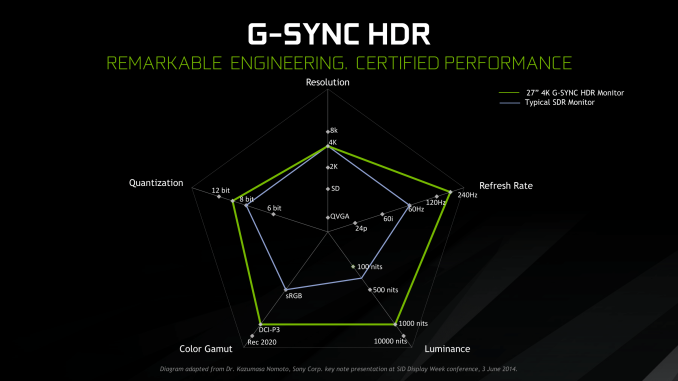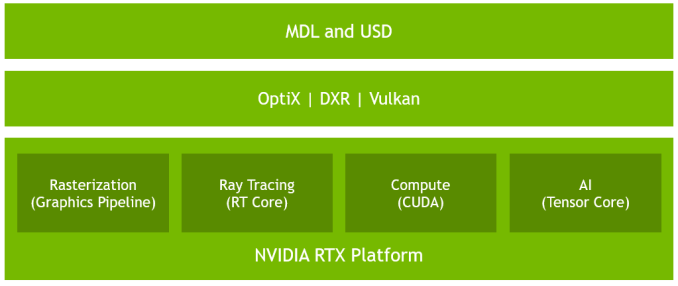The NVIDIA GeForce RTX 2080 Ti & RTX 2080 Founders Edition Review: Foundations For A Ray Traced Future
by Nate Oh on September 19, 2018 5:15 PM EST- Posted in
- GPUs
- Raytrace
- GeForce
- NVIDIA
- DirectX Raytracing
- Turing
- GeForce RTX
Meet The New Future of Gaming: Different Than The Old One
Up until last month, NVIDIA had been pushing a different, more conventional future for gaming and video cards, perhaps best exemplified by their recent launch of 27-in 4K G-Sync HDR monitors, courtesy of Asus and Acer. The specifications and display represented – and still represents – the aspired capabilities of PC gaming graphics: 4K resolution, 144 Hz refresh rate with G-Sync variable refresh, and high-quality HDR. The future was maxing out graphics settings on a game with high visual fidelity, enabling HDR, and rendering at 4K with triple-digit average framerate on a large screen. That target was not achievable by current performance, at least, certainly not by single-GPU cards. In the past, multi-GPU configurations were a stronger option provided that stuttering was not an issue, but recent years have seen both AMD and NVIDIA take a step back from CrossFireX and SLI, respectively.
Particularly with HDR, NVIDIA expressed a qualitative rather than quantitative enhancement in the gaming experience. Faster framerates and higher resolutions were more known quantities, easily demoed and with more intuitive benefits – though in the past there was the perception of 30fps as cinematic, and currently 1080p still remains stubbornly popular – where higher resolution means more possibility for details, higher even framerates meant smoother gameplay and video. Variable refresh rate technology soon followed, resolving the screen-tearing/V-Sync input lag dilemma, though again it took time to catch on to where it is now – nigh mandatory for a higher-end gaming monitor.
For gaming displays, HDR was substantively different than adding graphical details or allowing smoother gameplay and playback, because it meant a new dimension of ‘more possible colors’ and ‘brighter whites and darker blacks’ to gaming. Because HDR capability required support from the entire graphical chain, as well as high-quality HDR monitor and content to fully take advantage, it was harder to showcase. Added to the other aspects of high-end gaming graphics and pending the further development of VR, this was the future on the horizon for GPUs.
But today NVIDIA is switching gears, going to the fundamental way computer graphics are modelled in games today. Of the more realistic rendering processes, light can be emulated as rays that emit from their respective sources, but computing even a subset of the number of rays and their interactions (reflection, refraction, etc.) in a bounded space is so intensive that real time rendering was impossible. But to get the performance needed to render in real time, rasterization essentially boils down 3D objects as 2D representations to simplify the computations, significantly faking the behavior of light.
It’s on real time ray tracing that NVIDIA is staking its claim with GeForce RTX and Turing’s RT Cores. Covered more in-depth in our architecture article, NVIDIA’s real time ray tracing implementation takes all the shortcuts it can get, incorporating select real time ray tracing effects with significant denoising but keeping rasterization for everything else. Unfortunately, this hybrid rendering isn’t orthogonal to the previous concepts. Now, the ultimate experience would be hybrid rendered 4K with HDR support at high, steady, and variable framerates, though GPUs didn’t have enough performance to get to that point under traditional rasterization.
There’s a still a performance cost incurred with real time ray tracing effects, except right now only NVIDIA and developers have a clear idea of what it is. What we can say is that utilizing real time ray tracing effects in games may require sacrificing some or all three of high resolution, ultra high framerates, and HDR. HDR is limited by game support more than anything else. But the first two have arguably minimum performance standards when it comes to modern high-end gaming on PC – anything under 1080p is completely unpalatable, and anything under 30fps or more realistically 45 to 60fps hurts the playability. Variable refresh rate can mitigate the latter and framedrops are temporary, but low resolution is forever.
Ultimately, the real time ray tracing support needs to be implemented by developers via a supporting API like DXR – and many have been working hard on doing so – but currently there is no public timeline of application support for real time ray tracing, Tensor Core accelerated AI features, and Turing advanced shading. The list of games with support for Turing features - collectively called the RTX platform - will be available and updated on NVIDIA's site.













337 Comments
View All Comments
Chawitsch - Thursday, September 20, 2018 - link
Besides artists, programmers working on such demos also deserve high praise of course.Bateluer - Thursday, September 20, 2018 - link
Clearly, we're firmly in the age of 4K gaming for the upper range of cards. From Vega 64, 1080, 1080Ti, 2080, 2080Ti, all are throwing up very playable performance on 4K resolutions. I still expect to see people say you'll need SLI 2080TIs for 4K gaming, but that rings incredibly hollow when even a Vega 56 can deliver playable frame rates in most games at 4K with near maximum settings.kallogan - Thursday, September 20, 2018 - link
Higher perf but higher power consumption, this is barely an improvement. Skip.kallogan - Thursday, September 20, 2018 - link
There is absolutely no point whatsoever to buy these over a 1080 Ti indeedLuke212 - Thursday, September 20, 2018 - link
why did you not show the other cards for SGEMM? epic fail. nothing to compare them to.martixy - Thursday, September 20, 2018 - link
My takeaway:1080 owners and above should hold off, 1070 and below are probably justified in upgrading, with an eye to the future as the technologies baked in these cards mature and games utilizing them are released.
TheinsanegamerN - Thursday, September 20, 2018 - link
I highly doubt that those that bought a $350 card are looking at a $1200 card as an upgrade.Holliday75 - Friday, September 21, 2018 - link
I am running a GTX970 and have zero interest in this generation of cards at that price. I am going to let the market settle, AMD release its next batch of cards or two and see where things are a year or two from now. Waste of money as far as I am concerned.RSAUser - Thursday, September 20, 2018 - link
The 1080 Ti partner cards are substantially better than the FE ones, any chance of adding that to the benchmark?Ryan Smith - Thursday, September 20, 2018 - link
Unfortunately not. We like to keep our comparisons apples-to-apples. In this case using reference cards or the thing closest to one.Plus we don't have any other 1080 Tis in right now.